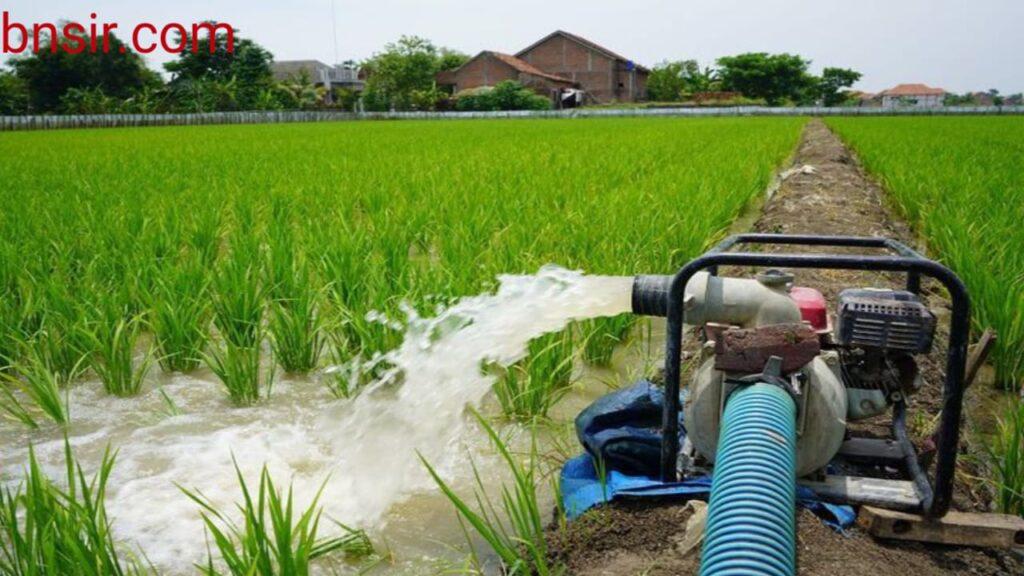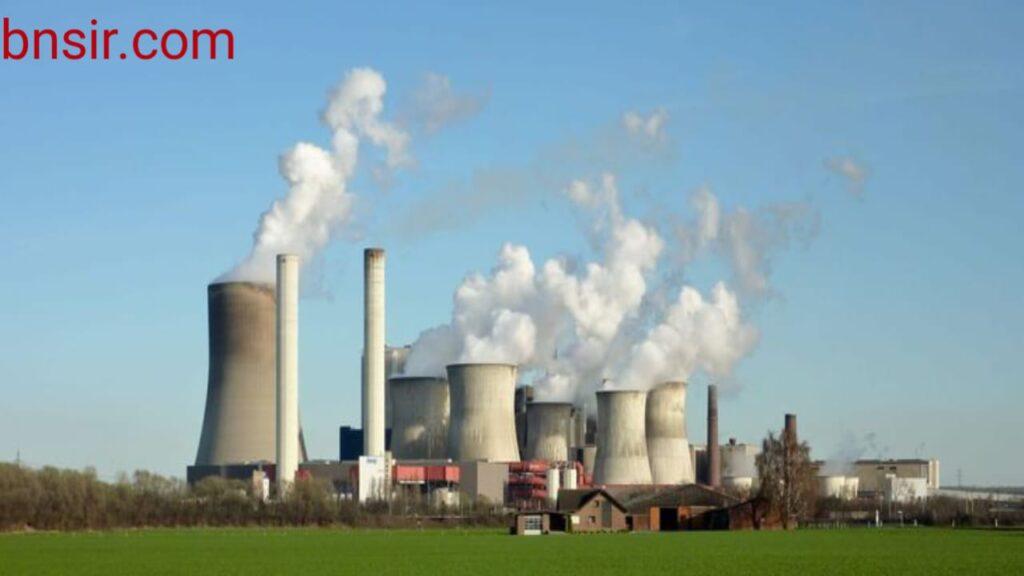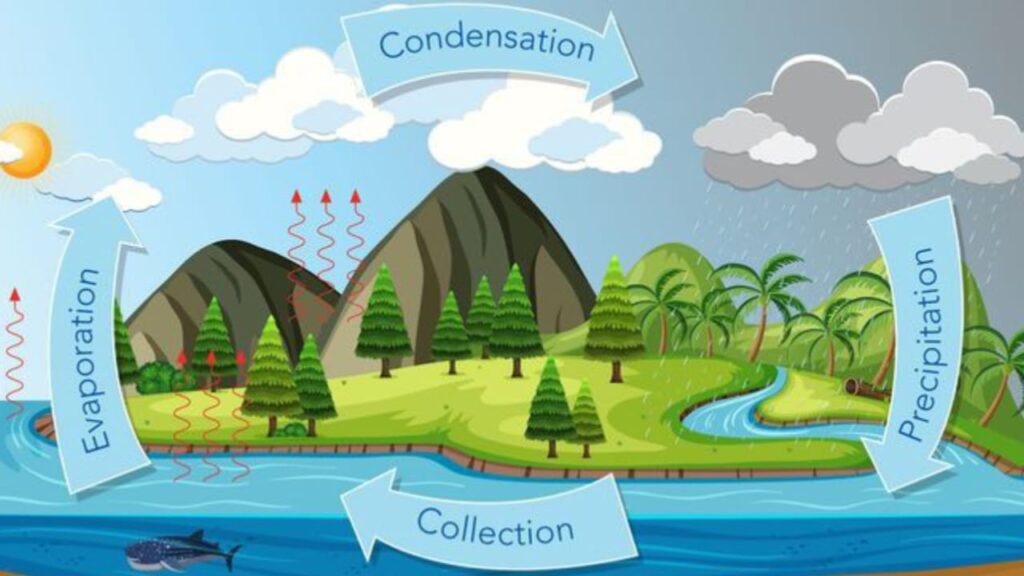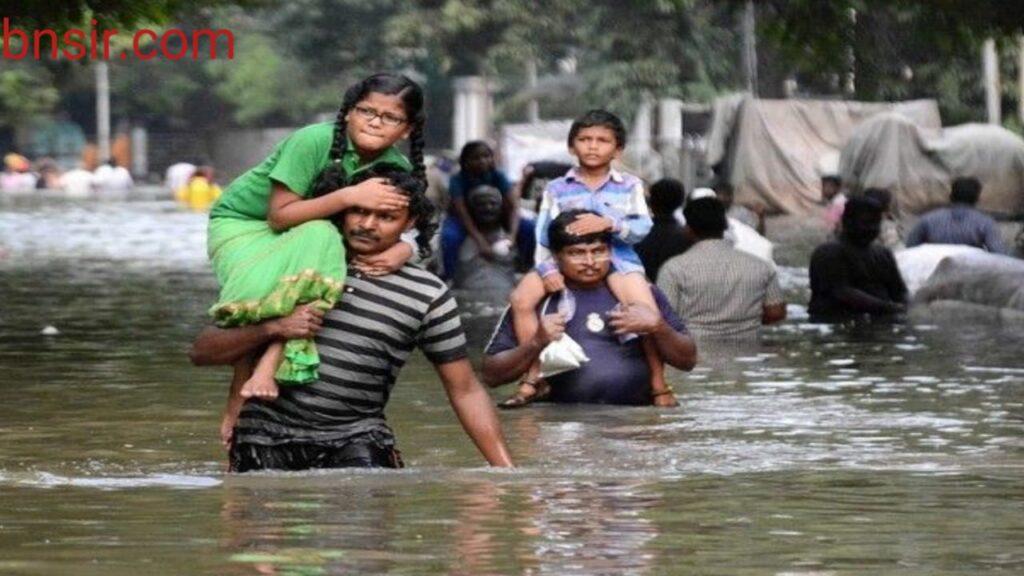Life would not have been possible on earth without water. In fact, life originated in water. Water covers three-fourths of the earth’s surface. It makes up 70 per cent of our body and 80 to more than 95 per cent of fruits and vegetables
In ancient times, Water was considered an element. But now it is established that it is a compound of hydrogen and oxygen. Among all the compounds found on earth, water is the most abundant.
WATER IS ESSENTIAL FOR LIFE
It is essential for every living being-plant or animal. It acts in life processes in three ways.
- By taking part in biochemical reactions The chemical reactions that take place in a living being are called biochemical reactions. Photosynthesis is a biochemical reaction in which water reacts with carbon dioxide in the presence of sunlight and chlorophyll to form glucose.
- By acting as a medium Water acts as a medium for the processes inside the body of a living being. The reactions involved in digestion, for example, cannot take place in the absence of water. Its also helps in the transport of substances inside the body. For example, nutrients move in solution from one part to another inside a plant. Blood, which contains a lot of it, carries nutrients, gases, wastes, and so on. from one part of the body to another. The waste products expelled by the body as urine are also dissolved in it.
- By acting as a coolant Water helps to regulate th temperature of the body. In summer. you sweat a lot. The evaporation of the sweat helps to cool down your body.
THE USES OF WATER
We need it for various purposes. The main uses of water can be classified into household, agricultural and industrial.
Household use:
We use it for drinking, cooking, bathing, washing, cooling and gardening. We also use it for flushing toilets and cleaning floors. We realise how important is not to waste water when the water supply falls for a couple of days. There are some things you could do at home to avoid wasting it. For instance, you should not leave the tap on while brushing your teeth-you should use a mug of water instead. Also, you could easily bathe using a bucket of water. If you leave the tap on, you could end up using three buckets of water.
Agricultural use:
Like all plants, crops need water for (1) photosynthesis, (ii) drawing minerals from the soll. and (ii) transporting substances from one part to another. They also lose a lot of water by evaporation, mainly from the leaves. This loss of water is known as transpiration. The amount of water thus lost is several hundred times greater than that used by plants for other purposes.
So, a large amount of it is required for producing a crop. You may be surprised to learn that for producing 1 kg of com. the plants use 350 kg. Le.. 350 L. of water. We say that the water requirement of corn is 350. The water requirement of wheat is 500 and that of potatoes is 636.

The soil must contain sufficient moisture to meet to the needs of the crop growing on it. It may not rain enough for the soil to be sufficiently moist. That is why farmers need to irrigate the land. Huge amounts of water are required for this purpose.
Industrial use:
Industries are often set up on the banks of rivers because they need huge quantities of water for the following purposes.
- As a reactant (a substance taking part in a chemical reaction is called a reactant)
- As a solvent
- Steam is used for the production of electricity and for other purposes
- For the disposal of wastes
- As a coolant

Evaporation and condensation: Evaporation and condensation of it take place frequently in nature. Let us take a look at these phenomena in some detail.
Evaporation You know that when a liquid changes into the vapour (gaseous) state, we say that the liquid has vaporised. Vaporisation is fast at the boiling point of the liquid. But the change in state from liquid to vapour also takes place below the boiling point. This is called evaporation. You must have observed that a small amount of water spilt on the floor disappears on its own. And wet clothes dry when hung on a clothes line. All this happens because it evaporates into the atmosphere.
Conditions that help evaporation In short, the following conditions help evaporation
1. A high temperature The higher the temperature. the faster is the evaporation of a liquid.
2. Low humidity Air always contains water vapour. But there is a limit up to which it can take up water vapour. When air contains much less water vapour than its capacity, its humidity is said to be low, or the air is said to be dry. When it contains a lot of vapour-close to its capacity-the air is said to be humid. Naturally, humid air can take up less water vapour than dry air. In other words, evaporation takes place faster in dry air. This is why wet clothes dry faster in summer than in the rainy season.
3. A large surface area The larger the surface area. the faster is the evaporation of a liquid. This is because molecules evaporate only from the surface of a liquid. By spreading out wet clothes on a clothes line, we increase the surface area of the clothes.
4. Draught A draught helps a liquid to evaporate.
Condensation A change in state from gaseous to liquid is called condensation.
If you place some ice in a glass or take out a bottle of water from a fridge, the walls of the glass or bottle will look hazy. This is because droplets of water collect on the outside of the glass or bottle. making it look hazy. If you leave the bottle or glass for a few minutes, the droplets combine to form bigger drops. Being heavy, the drops trickle down and collect at the bottom.
Where does this water come from? It comes from the surrounding air. Air contains its vapour, which condenses on being cooled.
THE WATER CYCLE
Water from the land and sea continuously evaporates into the atmosphere. Also, we use up a lot of it for different purposes. Yet the amount of it on the earth is almost constant. This is because the water is not lost-It only circulates among the land, sea and air. This circulation of water is called the water cycle. We will study it in three parts.
Evaporation and condensation
Water evaporates from the oceans, lakes, rivers and ponds, as well as from plants and animals. If the air is too cold, as on winter nights, the water vapour condenses at a very low height and forms a fog. A fog may extend from the ground up to a height of about three-fourths of a kilometre. In the day. if it is warm, the vapour rises with hot air. With increasing height, it becomes colder. Nearly a kilometre above the surface of the earth, it is cold enough for the water vapour to condense into droplets around dust particles to form clouds.
Precipitation
The droplets in the clouds are extremely small. They are so small that hundreds of thousands of them may have to combine to form a drop. When the droplets become large, they fall. While falling, if they meet hot air, they again get vaporised. But if they meet cold air or cold mountains, they fall as rain. Forests also attract rain because they are cool.

In very high clouds, its freezes into crystals of ice because it is very cold. These crystals fall as snowflakes when they become heavy. Sometimes rain passes through a very cold layer of air and freezes into hailstones.
During a cold night, the water vapour of the air condenses into droplets over any surface exposed to it. This is called dew. If you have played outdoor games like cricket or football early in the morning in winter, you may have noticed that the ground is wet with dew. The dew evaporates in the sun as the day progresses.
The deposition of water from the atmosphere onto the earth in any form-liquid or solid-is called precipitation. Rain, snow, hail and dew are forms of precipitation
Return to the ocean
Its falls as rain or snow returns to the oceans. Land is at a higher level than the ocean. Therefore, most of the rainwater runs off to oceans, either directly or through rivers and streams. Snow from the mountains melts and runs off to rivers, which merge with the oceans. The water we use for various purposes is discharged into lakes, rivers or oceans after being treated. So, this water too returns to the oceans. The oceans also get plenty of it directly through rainfall.
We have already defined the water cycle. It can also be defined as the continual exchange of it between the air, the land and the ocean. Life on land would not have been possible without the water cycle.
SOURCES OF WATER
We depend upon three main sources of surface water, ground water and rain.
Surface water
Its bodies like rivers, lakes and ponds form a major source of it for us. The water from these is called fresh water. Seas and some lakes, on the other hand, contain salt water, which cannot be used for household, agricultural or industrial purposes. But evaporation from the sea is the major source of rainfall. And rain replenishes our surface and groundwater resources.
Groundwater
There is a great reservoir of it underground. This is called groundwater. Let us see how it is formed.
A part of the rain that falls over land seeps (we also say that it percolates) through the soil. It displaces the air trapped between soil particles. It also passes through some kinds of rocks, and slowly moves downwards till it meets rocks which it cannot permeate. Above such rocks, this water accumulates. The zone in which this water accumulates is called the saturated zone. Thus a reservoir of groundwater is formed. The level of groundwater is known as the water table.
Groundwater is pumped out through manually operated or power-operated tubewells. It is good for household, agricultural and industrial purposes.
Is groundwater everlasting? Groundwater is not everlasting. With the growing population, the need for it is also increasing. When too much groundwater is pumped out, the water table falls. And quite often it falls below the lower end of the pipe in the borewell. Then no water can be pumped out. Groundwater is partially replenished by the direct seepage of rainwater. It is also replenished by seepage from a nearby river, if any. Then the water table rises again.
You may have seen it gushing out from under the ground from a spring. This water is groundwater. Springs supply water to many lakes and ponds.
DROUGHT AND FLOOD-THE TWO EXTREMES
We have just discussed the role rain plays in renewing our water resources. Lack of rainfall can destroy crops and create an acute water shortage. Too much rain can also cause widespread destruction and loss of life.
What will happen if it does not rain?
For us, the major source of it is rain. If it does not rain, the soil dries up and becomes too hard. Big cracks develop in the soil. Plants do not get moisture, but transpiration continues: So the plants lose it very fast and finally die. Grass does not grow and animals have nothing to graze on.
Without rainfall, there is no water to irrigate the crop land. So crops get destroyed and there is a shortage of food. Farmers who depend on crops for their survival suffer immensely. Rivers, lakes, ponds and wells dry up. The water table falls and borewells fail. This leads to a shortage of drinking water. When a place faces such conditions due to poor or no rainfall for a year or two, we say that there is a drought.
What will happen if it rains heavily?
When it rains heavily. the soil soon gets saturated with water. All the water cannot seep through. Moreover, roads and buildings also stop seepage. So, its accumulates over the land. This condition is called waterlogging. When it rains continuously for several days, rivers overflow, and the land gets submerged. This is called a flood.

Too much water in the soil displaces most of the air Therefore, animals living underground. like earthworms and snakes. come out in search of air. As the roots of plants cannot move, the plants die.
When ponds, lakes and rivers overflow, the aquatic animals living in them also get forced out. There is great loss of aquatic life. Floods also ruin crops. They can also cause massive loss of life and damage to property. Floods wash away the upper layer of the soil. We call this the erosion of soil. Plants and trees prevent erosion because their roots hold the soil particles strongly. Trees also break the force of flood water. To prevent soil erosion, we must discourage the cutting of trees and the uprooting of other plants.
LET US CONSERVE WATER
The need for water is increasing every day with rise in population. We have to grow more food, so we need more for irrigation. Industries also must expand to cater for our needs. This too adds to the demand for it.
We must, therefore, realise the need for using water very carefully. When we use a resource very carefully so that it lasts as long as possible, we say that we conserve it. One way of conserving it is to make use of rainwater. Making use of rainwater is known as rainwater harvesting.
Rainwater usually runs off into rivers and then into the sea. Some of it seeps through the soil to renew groundwater resources. But in urban areas, where the soil is covered with concrete structures and metalled roads, even this is prevented. We can, however, make an effort to utilise rainwater instead of allowing it to run off. Here are some ways of harvesting rainwater.
- Pits or tanks are dug in low-lying areas to collect rainwater. This water can be filtered. disinfected and supplied for consumption. Sometimes, the collected water (after being filtered) is fed into the dried-up borewells to replenish the groundwater reservoir.
- Rooftop rainwater harvesting is also useful. The rainwater from the roof of a house is collected through pipes in tanks on the ground. How much water do we get this way? Let us suppose the roof area of a house is 100 m². the annual rainfall is 100 cm (1 m). and that we are able to collect only 70% of the rainwater. Then the volume of water collected in a year is 100 m x 1 mx (70/100) 70 m = 70.000 L. For a family of four, requiring 400 L of water a day, the harvested water will run for 175 days. i.e… about 6 months.
- In a hilly area, where there are hills on three sides, a reservoir is made by raising a dam on the fourth side. The harvested rainwater is supplied to the nearby city.
Water | Understand 2 Easy Ways by YouTube Vedio:

